2003 PONTIAC GRAND PRIX towing
[x] Cancel search: towingPage 223 of 378
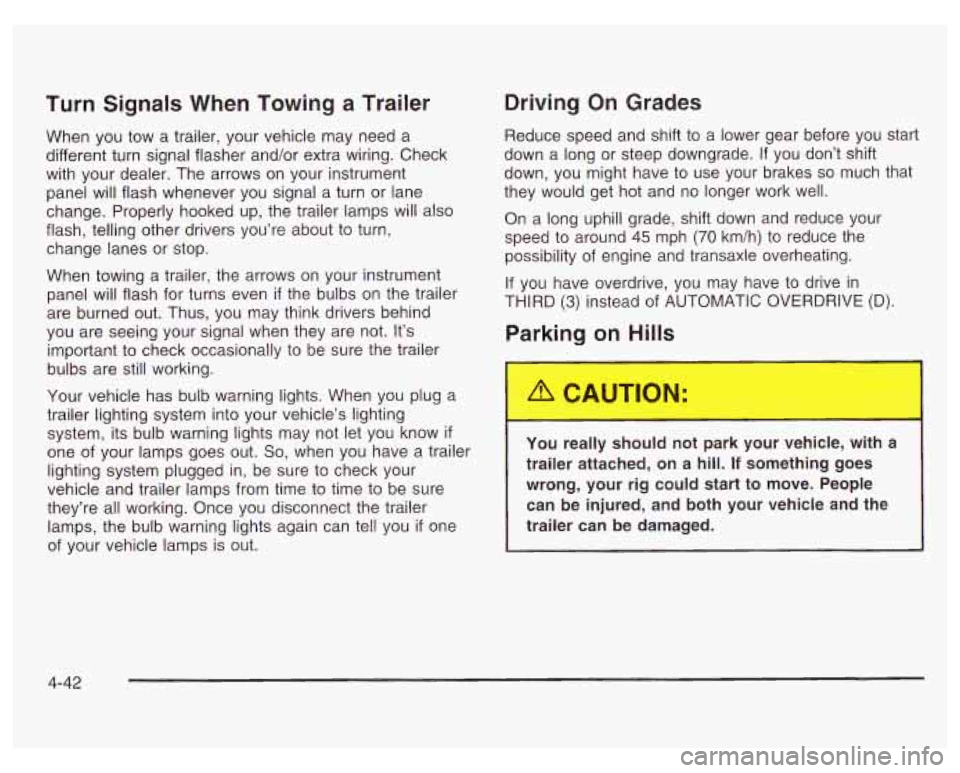
Turn Signals When Towing a Trailer
When you tow a trailer, your vehicle may need a
different turn signal flasher and/or extra wiring. Check
with your dealer. The arrows on your instrument
panel will flash whenever you signal a turn or lane
change. Properly hooked up, the trailer lamps will also
flash, telling other drivers you’re about to turn,
change lanes or stop.
When towing a trailer, the arrows on your instrument
panel will flash for turns even
if the bulbs on the trailer
are burned out. Thus, you may think drivers behind
you are seeing your signal when they are not. It’s
important to check occasionally to be sure the trailer
bulbs are still working.
Your vehicle has bulb warning lights. When you plug a
trailer lighting system into your vehicle’s lighting
system, its bulb warning lights may not let you know
if
one of your lamps goes out. So, when you have a trailer
lighting system plugged in, be sure to check your
vehicle and trailer lamps from time to time to be sure
they’re all working. Once you disconnect the trailer
lamps, the bulb warning lights again can tell you
if one
of your vehicle lamps is out.
Driving On Grades
Reduce speed and shift to a lower gear before you start
down a long or steep downgrade.
If you don’t shift
down, you might have to use your brakes
so much that
they would get hot and no longer work well.
On a long uphill grade, shift down and reduce your
speed to around
45 mph (70 km/h) to reduce the
possibility of engine and transaxle overheating.
If you have overdrive, you may have to drive in
THIRD (3) instead of AUTOMATIC OVERDRIVE (D).
Parking on Hills
1 -J really should not ,,rk yo^, wG,kle, with a
trailer attached, on a hill.
If something goes
wrong, your rig could start to move. People
can be injured, and both your vehicle and the
trailer can be damaged.
4-42
Page 224 of 378

But if you ever have to park your rig on a hill, here’s
how to do it:
1.
2.
3.
4.
5.
Apply your regular brakes, but don’t shift into
PARK
(P) yet.
Have someone place chocks under the trailer
wheels.
When the wheel chocks are in place, release the
regular brakes until the chocks absorb the load.
Reapply the regular brakes. Then apply your
parking brake, and then shift to PARK
(P).
Release the regular brakes.
When You Are Ready to Leave After
Parking on a
Hill
1. Apply your regular brakes and hold the pedal down
while you:
start your engine,
0 shift into a gear, and
0 release the parking brake. 2. Let
up on the brake pedal.
3. Drive slowly until the trailer is clear of the chocks.
4. Stop and have someone pick up and store the
chocks.
Maintenance When Trailer Towing
Your vehicle will need service more often when you’re
pulling a trailer. See Part
A: Scheduled Maintenance
Services on page
6-4 for more information. Things that
are especially important in trailer operation are
automatic transaxle fluid (don’t overfill), engine oil, drive
belts, cooling system and brake system. Each of
these is covered in this manual, and the Index will help
you find them quickly.
If you’re trailering, it’s a good
idea to review this information before you start your trip.
Check periodically
to see that all hitch nuts and bolts
are tight.
Engine Cooling When Trailer Towing
Your cooling system may temporarily overheat during
severe operating conditions. See Engine Overheating
on page
5-33.
4-43
Page 252 of 378
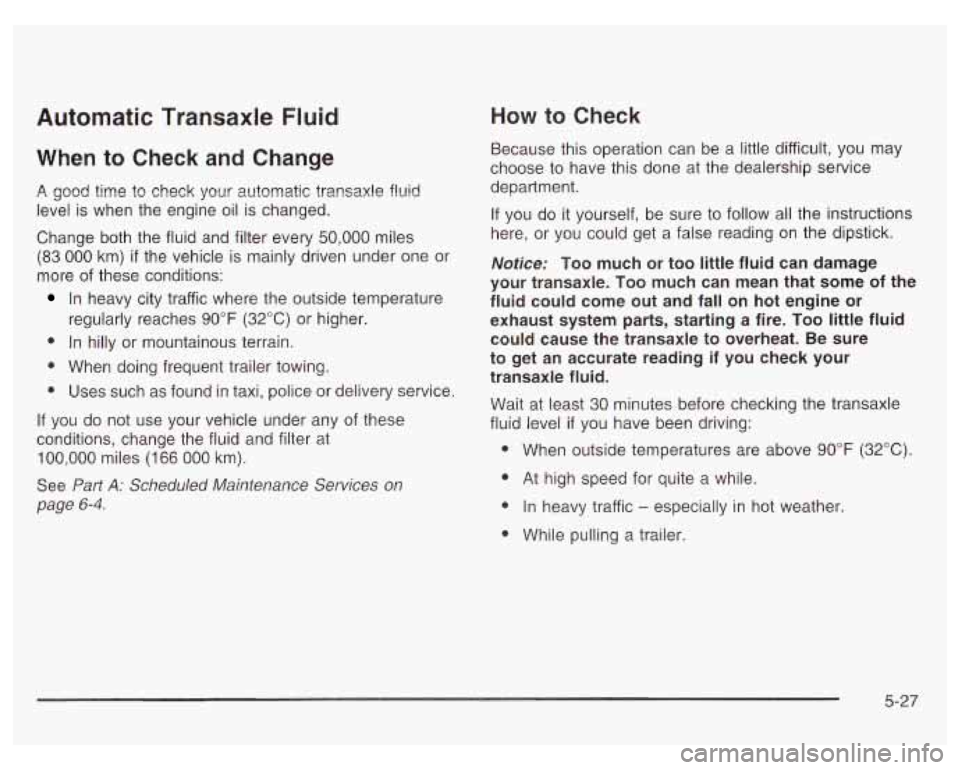
Automatic Transaxle Fluid
When to Check and Change
A good time to check your automatic transaxle fluid
level is when the engine oil is changed.
Change both the fluid and filter every 50,000 miles
(83
000 km) if the vehicle is mainly driven under one or
more of these conditions:
In heavy city traffic where the outside temperature
0 In hilly or mountainous terrain.
0 When doing frequent trailer towing.
0 Uses such as found in taxi, police or delivery service.
regularly reaches
90°F (32°C)
or higher.
If you do not use your vehicle under any of these
conditions, change the fluid and filter at
100,000 miles (166 000 km).
See Part
A: Scheduled Maintenance Services on
page
6-4.
How to Cheek
Because this operation can be a little difficult, you may
choose to have this done at the dealership service
department.
If you do it yourself, be sure to follow all the instructions
here, or you could get a false reading on the dipstick.
Nofice: Too much or too little fluid can damage
your transaxle.
Too much can mean that some of the
fluid could come out and fall on hot engine or
exhaust system parts, starting a fire.
Too little fluid
could cause the transaxle to overheat. Be sure
to get an accurate reading
if you check your
transaxle fluid.
Wait at least 30 minutes before checking the transaxle
fluid level
if you have been driving:
When outside temperatures are above
90°F (32°C).
At high speed for quite a while.
In heavy traffic
- especially in hot weather.
While pulling a trailer.
5-27
Page 258 of 378
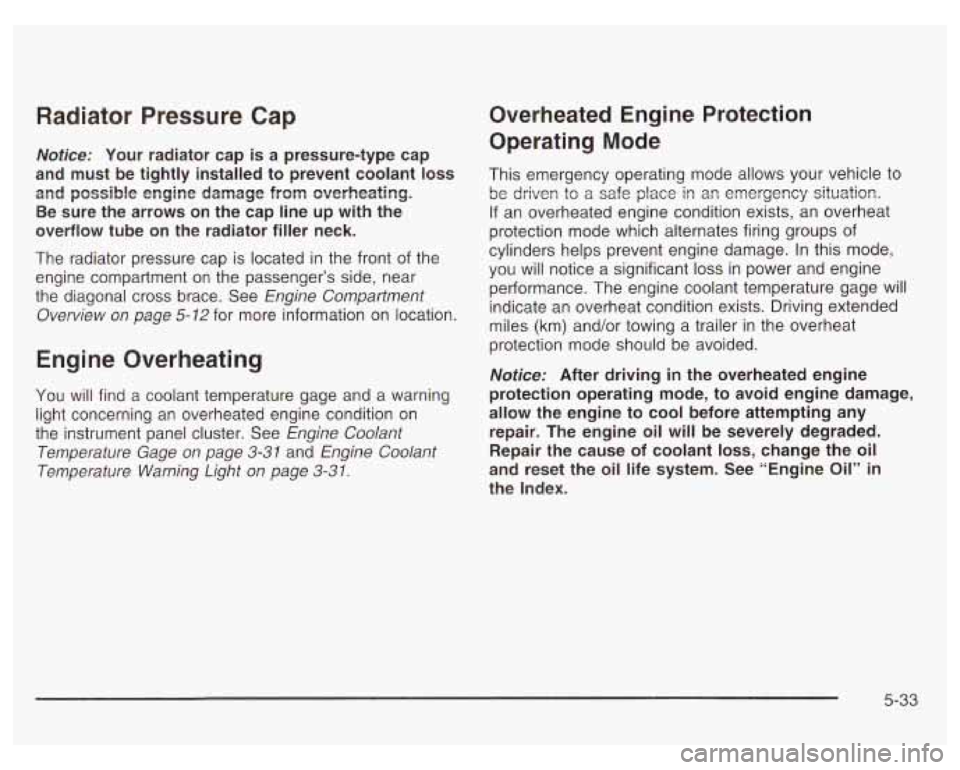
Radiator Pressure Cap
Notice: Your radiator cap is a pressure-type cap
and must be tightly installed to prevent coolant
loss
and possible engine damage from overheating.
Be sure the arrows on the cap line up with the
overflow tube
on the radiator filler neck.
The radiator pressure cap is located in the front of the
engine compartment on the passenger’s side, near
the diagonal cross brace. See Engine Compartment
Overview on page
5-12 for more information on location.
Engine Overheating
You will find a coolant temperature gage and a warning
light concerning an overheated engine condition on
the instrument panel cluster. See Engine Coolant
Temperature Gage
on page 3-31 and Engine Coolant
Temperature Warning Light
on page 3-31.
Overheated Engine Protection
Operating Mode
This emergency operating mode allows your vehicle to
be driven tu
a safe place in an emergency situation.
If an overheated engine condition exists, an overheat
protection mode which alternates firing groups of
cylinders helps prevent engine damage. In this mode,
you will notice a significant
loss in power and engine
performance. The engine coolant temperature gage will
indicate an overheat condition exists. Driving extended
miles (km) and/or towing a trailer in the overheat
protection mode should be avoided.
Nofice: After driving in the overheated engine
protection operating mode, to avoid engine damage,
allow the engine to cool before attempting any
repair. The engine oil will be severely degraded.
Repair the cause of coolant
loss, change the oil
and reset the oil life system. See “Engine Oil”
ir
the Index.
5-33
Page 336 of 378
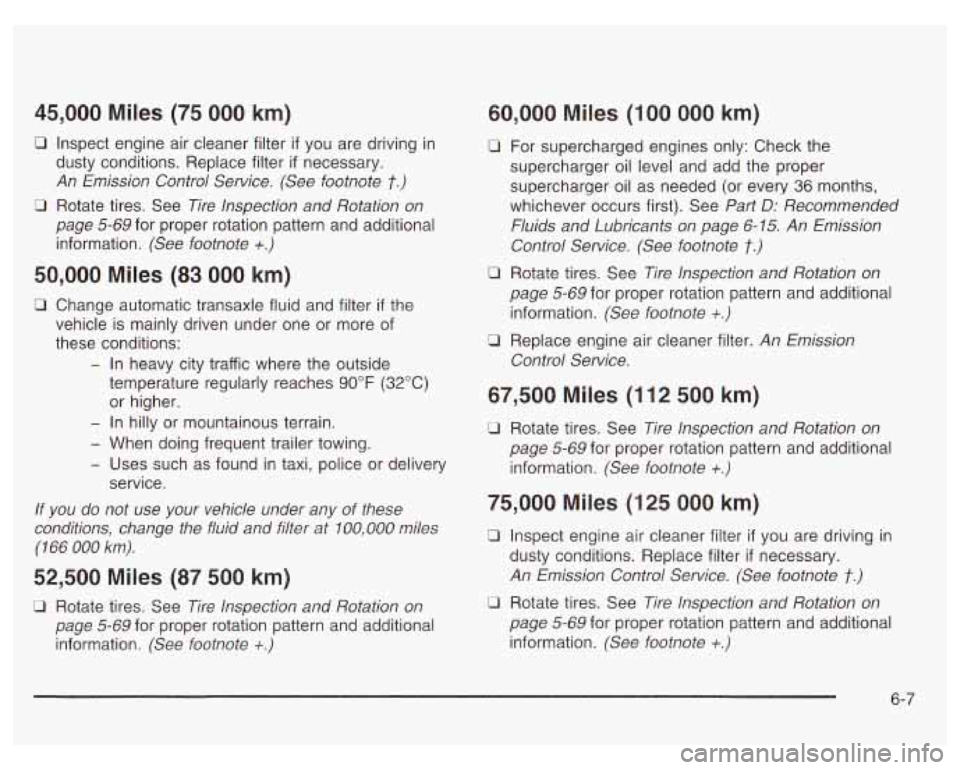
45,000 Miles (75 000 km)
0 Inspect engine air cleaner filter if you are driving in
dusty conditions. Replace filter
if necessary.
An Emission Control Service. (See footnote
t.)
0 Rotate tires. See Tire Inspection and Rotation on
page 5-69 for proper rotation pattern and additional
information. (See footnote
+.)
50,000 Miles (83 000 km)
0 Change automatic transaxle fluid and filter if the
vehicle is mainly driven under one or more of
these conditions:
- In heavy city traffic where the outside
temperature regularly reaches
90°F (32°C)
or higher.
- In hilly or mountainous terrain.
- When doing frequent trailer towing.
- Uses such as found in taxi, police or delivery
service.
If you do not use your vehicle under any of these
conditions, change the fluid and filter at
100,000 miles
(166
000 km).
52,500 Miles (87 500 km)
0 Rotate tires. See Tire Inspection and Rotation on
page 5-69 for proper rotation pattern and additional
information. (See footnote
+-)
60,000 Miles (100 000 km)
0 For supercharged engines only: Check the
supercharger
oil level and add the proper
supercharger oil as needed (or every
36 months,
whichever occurs first). See Part
D: Recommended
Fluids and Lubricants on page 6- 15. An Emission
Control Service. (See footnote
t.)
0 Rotate tires. See Tire Inspection and Rotation on
page 5-69 for proper rotation pattern and additional
information. (See footnote
+.)
Control Service.
0 Replace engine air cleaner filter. An Emission
67,500 Miles (112 500 km)
U Rotate tires. See Tire Inspection and Rotation on
page 5-69 for proper rotation pattern and additional
information. (See footnote
+.)
75,000 Miles (125 000 km)
0 Inspect engine air cleaner filter if you are driving in
dusty conditions. Replace filter
if necessary.
An Emission Control Service. (See footnote
t.)
0 Rotate tires. See Tire Inspection and Rotation on
page 5-69 for proper rotation pattern and additional
information. (See footnote
+.)
6-7
Page 337 of 378

82,500 Miles (137 500 km)
0 Rotate tires. See Tire Inspection and Rotation on
page
5-69 for proper rotation pattern and additional
information. (See footnote
+.)
90,000 Miles (150 000 km)
0 Replace engine air cleaner filter. An Emission
Control Service.
0 For supercharged engines only: Check the
supercharger oil level and add the proper
supercharger oil as needed (or every 36 months,
whichever occurs first). See Part D: Recommended
Fluids and Lubricants on page
6-15. An Emission
Control Service. (See footnote
f.)
Ll Rotate tires. See Tire Inspection and Rotation on
page 5-69 for proper rotation pattern and additional
information. (See footnote
+.)
97,500 Miles (162 500 km)
U Rotate tires. See Tire Inspection and Rotation on
page 5-69 for proper rotation pattern and additional
information. (See footnote
+.)
100,000 Miles (1 66 000 km)
0 Inspect spark plug wires. An Emission Control
0 Replace spark plugs. An Emission Control Service.
Service.
CI Change
automatic transaxle fluid and filter if the
vehicle is mainly driven under one or more
of
these conditions:
- In heavy city traffic where the outside
temperature regularly reaches
90°F (32°C)
or higher.
- In hilly or mountainous terrain.
- When doing frequent trailer towing.
- Uses such as found in taxi, police or delivery
service.
0 If you haven’t used your vehicle under severe service
conditions listed previously and, therefore, haven’t
changed your automatic transaxle fluid, change both
the fluid and filter.
150,000 Miles (240 000 km)
0 Drain, flush and refill cooling system (or every
60 months since last service, whichever occurs first).
See Engine Coolant on page
5-30 for what to use.
Inspect hoses. Clean radiator, condenser, pressure
cap and neck. Pressure test the cooling system
and pressure cap. An Emission Control Service.
0 Inspect engine accessory drive belt. An Emission
Control Service.
6-8
Page 363 of 378
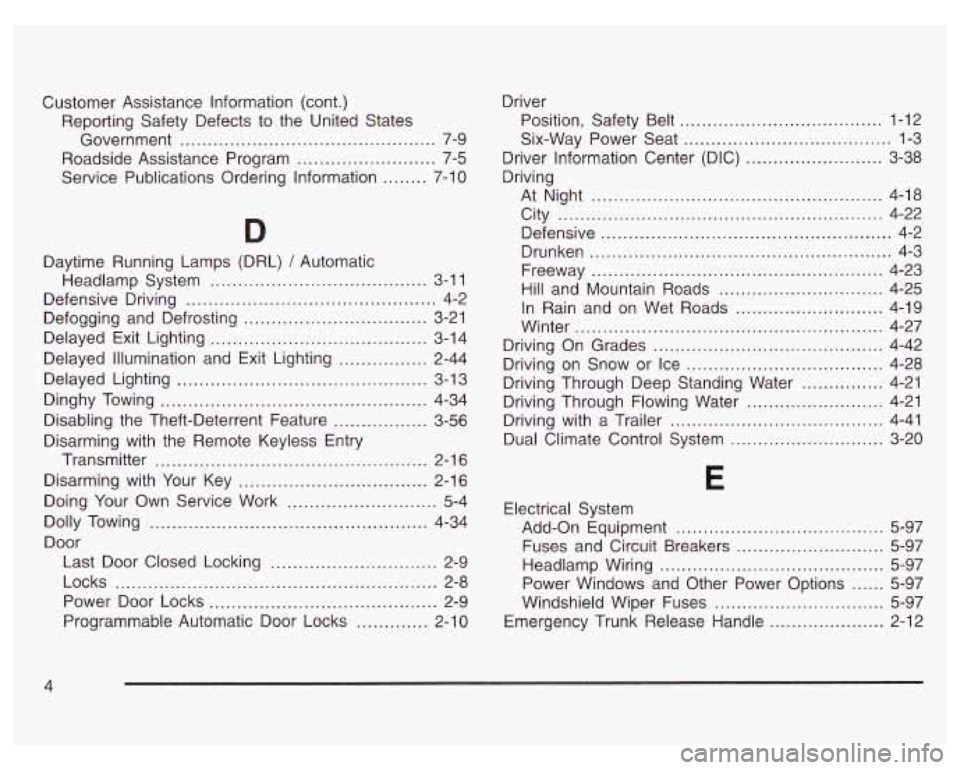
Customer Assistance Information (cont.)
Reporting Safety Defects to the United States
Government
.............................................. 7-9
Roadside Assistance Program
......................... 7-5
Service Publications Ordering Information
........ 7-1 0
D
Daytime Running Lamps (DRL) / Automatic
Headlamp System
....................................... 3-1 1
Defensive Driving ............................................. 4-2
Defogging and Defrosting
................................. 3-21
Delayed Exit Lighting
....................................... 3-14
Delayed Illumination and Exit Lighting
................ 2-44
Delayed Lighting
............................................. 3-1 3
Dinghy Towing
................................................ 4-34
Disabling the Theft-Deterrent Feature
................. 3-56
Disarming with the Remote Keyless Entry
Transmitter
................................................. 2-1 6
Disarming with Your Key
.................................. 2-16
Doing Your Own Service Work
........................... 5-4
Dolly Towing
.................................................. 4-34
Door Last Door Closed Locking
.............................. 2-9
Power Door Locks
......................................... 2-9
Programmable Automatic Door Locks
............. 2-1 0
Locks .......................................................... 2-8 Driver
Position. Safety Belt
..................................... 1-12
Six-Way Power Seat
...................................... 1-3
Driver Information Center (DIC)
......................... 3-38
Driving At Night
..................................................... 4-18
City
........................................................... 4-22
Defensive
..................................................... 4-2
Drunken
....................................................... 4-3
Freeway
..................................................... 4-23
Hill and Mountain Roads
.............................. 4-25
In Rain and on Wet Roads
........................... 4-19
Winter
........................................................ 4-27
Driving On Grades
.......................................... 4-42
Driving on Snow or Ice
.................................... 4-28
Driving Through Deep Standing Water
............... 4-21
Driving Through Flowing Water
......................... 4-21
Dual Climate Control System
............................ 3-20
Driving with
a Trailer
....................................... 4-41
Electrical System
Add-on Equipment
.......... ................. 5-97
Fuses and Circuit Breakers
................... 5-97
Headlamp Wiring
......................................... 5-97
Power Windows and Other Power Options
...... 5-97
Windshield Wiper Fuses
............................... 5-97
Emergency Trunk Release Handle
................. 2-12
4
Page 364 of 378
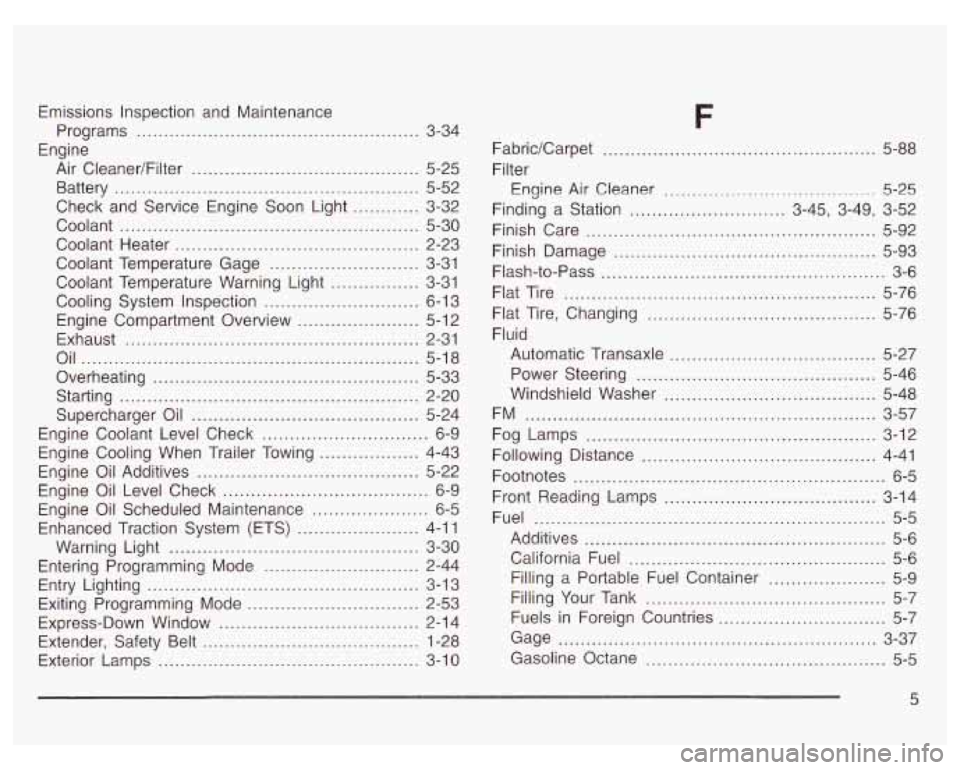
Emissions Inspection and Maintenance
Engine Programs
................................................... 3-34
Air Cleaner/Filter
......................................... 5-25
Battery
....................................................... 5-52
Check and Service Engine Soon Light ............ 3-32
Coolant
...................................................... 5-30
Coolant Heater
............................................ 2-23
Coolant Temperature Gage
........................... 3-31
Coolant Temperature Warning Light
................ 3-31
Cooling System Inspection
............................ 6-1 3
Engine Compartment Overview
...................... 5-1 2
Exhaust ..................................................... 2-31
Oil
............................................................. 5-18
Starting
...................................................... 2-20
Supercharger Oil
......................................... 5-24
Engine Coolant Level Check
.............................. 6-9
Engine Cooling When Trailer Towing
.................. 4-43
Engine Oil Additives
........................................ 5-22
Engine Oil Level Check
..................................... 6-9
Engine Oil Scheduled Maintenance
..................... 6-5
Warning Light
............................................. 3-30
Entering Programming Mode
......................... 2-44
Entry Lighting
........................ ...... 3-13
Exiting Programming Mode
.......... ...... 2-53
Extender, Safety Belt
.. ...................... 1-28
Exterior Lamps
............................................... 3-1 0
Overheating ................................................ 5-33
Enhanced Traction System (ETS)
...................... 4-1 1
Express-Down Window
................................. 2-1 4
F
, ........... FabridCarpet ........... ........... 5-88
Filter
Engine Air Cleaner ............................... :~~=:=~ 5-25
Finding a Station ............................ 3-45, 3-49, 3-52
Finish Care
.................................................... 5-92
Finish Damage
............................................... 5-93
Flash-to-Pass
................................................... 3-6
Flat Tire
........................................................ 5-76
Flat Tire, Changing
......................................... 5-76
Fluid Automatic Transaxle
..................................... 5-27
Power Steering
........................................... 5-46
Windshield Washer
...................................... 5-48
Fog Lamps
................................. , ........... 3-12
Following Distance
.......................................... 4-41
Footnotes
........................................................ 6-5
Front Reading Lamps
...................................... 3-14
Fuel
............................................................... 5-5
Additives ...................................................... 5-6
California Fuel
.............................................. 5-6
Filling a Portable Fuel Container
..................... 5-9
Filling Your Tank
........................................... 5-7
Fuels in Foreign Countries
.............................. 5-7
Gage
......................................................... 3-37
Gasoline Octane
........................................ 5-5
FM ............................................................... 3-57
5